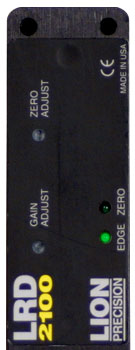The Zero adjustment on the LRD2100 is NOT a label adjustment and only needs to be adjusted once – when first put on the machine.
The Gain setting also rarely needs changing.
The LRD2100 ships with small black labels which can be placed over the adjustments (especially the Zero) to prevent unnecessary adjustment.
(The Zero and Gain adjustments have a maximum of 4 turns. Turning them beyond the end of the adjustment range will not damage the sensor; the adjustments will continue to turn, but no further adjustment will occur, and they may click.)
 Adjustments When First Intalled On A Machine
Adjustments When First Intalled On A Machine
- Set the Gain adjustment to maximum.
- Turn the Gain adjustment at least 4 full turns clockwise
- With NO material in the sensor, turn the Zero adjustment to the point where the Zero light changes between On and Off. It doesn’t matter whether it is On or Off when completed, as long as it is close to the point where it changes.
- Consider placing one of the included round black labels over the adjustment to prevent future unnecessary adjustments.
- Set the Gain to center of its range
- Turn the Gain adjustment 2 turns counterclockwise
The Zero may have to be adjusted again if the baseplate is ever replaced or the sensor is used without the baseplate.
Adjustments When Label Stock Is Changed
Usually None. The basic setting (Gain at center of its range) will work for most labels.
Very small labels may require an increase in Gain.
If, and ONLY if, the new labels aren’t being detected correctly, use this procedure:
- Re-Set the Gain to center of its range
- Turn the Gain adjustment at least 4 full turns clockwise
- Turn the Gain adjustment 2 turns counterclockwise
- Run and see if the sensor works correctly. If it does, the Gain had been adjusted and needed to be re-centered.
If NOT, then: - Set Gain to Minimum
- Turn the Gain adjustment 4 turns counterclockwise
- Move labels through the sensor and increase Gain (turn clockwise) until the Output light (“Edge” on older models) just begins to flash.
If possible, it may be easier to create some slack in the web and just move one gap back-and-forth through the sensor while adjusting. - Turn the Gain adjustment another half-turn clockwise.
If the sensor doesn’t detect labels reliably after this procedure, you may have label materials that don’t work well with a differential capacitive label sensor. In which case you will need another type of sensor (Single-Ended Capacitive or Ultrasonic).
